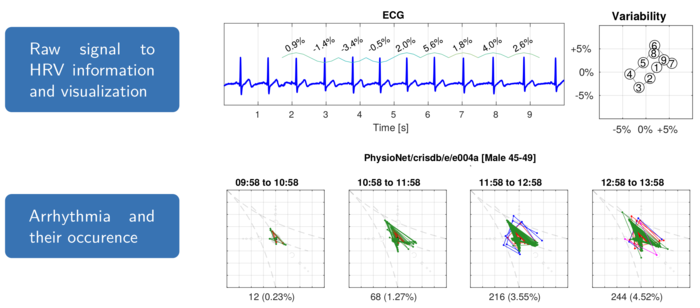Wikiversity:Fellow-Programm Freies Wissen/Einreichungen/Open Heart Beat
Open Heart Beat
[Bearbeiten]Project description
[Bearbeiten]Heart Rate Variability
[Bearbeiten]Heart rate variability (HRV) is a physiological marker of the autonomous activity of the human heart. The time between successive heart beats is in general not constant, it varies in a resting state of healthy people. It is associated with the respiration due to the activity of the parasympathetic nervous system. There are many methods to quantify HRV - turning RR intervals (time between heart beats) into some objective value of cardiac health, stress etc. In this respect, I developed an new analysis tool, called HRVTool. For a detailed description and to learn more about heart beat detection and HRV I invite you to read my dissertation.
HRVTool
[Bearbeiten]HRVTool is a graphical user interface for Matlab (HRVTool) and provides a lot of functions to analyze the heart beat information derived from various sources: Hexoskin wav files, PhysioNet ecg files, Polar hrm files, European Data Format edf files and mat or txt files containing waveforms or RR intervals are currently supported. It is possible to track the HRV measures segmentally in a long-term record, to visualize the RR interval series and to uncover patterns of intervals or extra systoles.
The very intuitive kind of data representation of even large records (long-term ECGs) can help physicians to keep track of the disease progress or circadian and treatment effects.
Open Heart Beat
[Bearbeiten]Nowadays the measurement of the cardiac activity is frequently performed in everyday life. Many personal smart devices (watches, shirts, smartphone apps) come up the last years to track fitness, health and stress. But in many cases the manufacturers keep the calculations for health states or fitness levels secret and unfortunately there is rarely an explanation in the manuals.
My research project offers an open source alternative in processing these kind of data. I want to transfer the user interface and methods that I wrote in Matlab into the open source statistical program GnuR. I want to build a RShiny web application for HRVTool, which brings the benefit of an open source online tool for HRV assessment. In order to achieve this objective, I present the following plan of expected working results:
- Transfer of source code from Matlab to R
- Building a RShiny app
- Export of results to a pdf report
- Export of processed data into an open data format
- Data donor possibility to improve algorithms
- Extension to arrhythmia detection
- Extension to detect pulse waves (phlethysmogram support)
- Support of slow-motion videos from smartphone based photoplethysmogram measurements
- Set-up a public discussion platform for user and developer
This project supports the idea of open science -- an open online tool for the analysis of heart rate and heart rate variability for scientists, physicians and layman. This project could also fill the gap of knowledge and interpretation of big data by simplification and visualization of ECG and pulse signals using transparent methods.
Marcus Vollmer
[Bearbeiten]- Name: Marcus Vollmer
- Institution: University Medicine Greifswald
- Kontakt: marcus.vollmer@uni-greifswald.de


